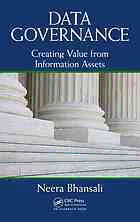Table Of ContentDATA
GOVERNANCE
Creating Value from
Information Assets
DATA
GOVERNANCE
Creating Value from
Information Assets
Neera Bhansali
Edited by
CRC Press
Taylor & Francis Group
6000 Broken Sound Parkway NW, Suite 300
Boca Raton, FL 33487-2742
© 2014 by Taylor & Francis Group, LLC
CRC Press is an imprint of Taylor & Francis Group, an Informa business
No claim to original U.S. Government works
Version Date: 20130227
International Standard Book Number-13: 978-1-4398-7914-6 (eBook - PDF)
This book contains information obtained from authentic and highly regarded sources. Reasonable efforts
have been made to publish reliable data and information, but the author and publisher cannot assume
responsibility for the validity of all materials or the consequences of their use. The authors and publishers
have attempted to trace the copyright holders of all material reproduced in this publication and apologize to
copyright holders if permission to publish in this form has not been obtained. If any copyright material has
not been acknowledged please write and let us know so we may rectify in any future reprint.
Except as permitted under U.S. Copyright Law, no part of this book may be reprinted, reproduced, transmit-
ted, or utilized in any form by any electronic, mechanical, or other means, now known or hereafter invented,
including photocopying, microfilming, and recording, or in any information storage or retrieval system,
without written permission from the publishers.
For permission to photocopy or use material electronically from this work, please access www.copyright.
com (http://www.copyright.com/) or contact the Copyright Clearance Center, Inc. (CCC), 222 Rosewood
Drive, Danvers, MA 01923, 978-750-8400. CCC is a not-for-profit organization that provides licenses and
registration for a variety of users. For organizations that have been granted a photocopy license by the CCC,
a separate system of payment has been arranged.
Trademark Notice: Product or corporate names may be trademarks or registered trademarks, and are used
only for identification and explanation without intent to infringe.
Visit the Taylor & Francis Web site at
http://www.taylorandfrancis.com
and the CRC Press Web site at
http://www.crcpress.com
Contents
Preface ...................................................................................................vii
Acknowledgments .................................................................................ix
The Editor ..............................................................................................xi
Contributors ........................................................................................xiii
Chapter 1 The Role of Data Governance in an Organization ..........1
Neera Bhansali
Chapter 2 Navigating the Organization to Ensure
Data Governance ..............................................................19
Neera Bhansali
Chapter 3 Metadata Management and Data Governance ...............43
Michael Schrader
Chapter 4 Operationalizing Data Quality through
Data Governance ..............................................................65
Julia Zhang
Chapter 5 Semantic Analytics and Ontologies ................................93
Osamu Takaki, N. Izumi, K. Murata, and K. Hasida
Chapter 6 Data Privacy, Security, and Compliance through
Data Governance ............................................................125
Charlyn A. Hilliman
Chapter 7 Adaptive Data Governance: The AT-EASE Change
Management Approach ..................................................149
Dasaratha Rama
v
vi • Contents
Chapter 8 Case Study: State Level Governance of
Health Information Exchange .......................................175
Christopher B. Sullivan
Chapter 9 Bridging the Gap between Business and IT:
An Information Governance Perspective in the
Banking Industry ...........................................................217
Fernando A. Faria and Gladys E. Simpson
Index ....................................................................................................241
Preface
As a rule, he or she who has the most information will have the greatest
success in life.
Benjamin Disraeli
In recent years, there has been enormous growth of data in organizations.
This data has become the basis of competition, productivity, growth, and
innovation. The rise in volume of data through the Internet, social media,
and multimedia is adding new challenges and opportunities for harnessing
the power of information. There is much discussion today on using orga-
nizational data to derive value. As organizations respond to strategic and
operational challenges that demand high-quality data, data governance
is emerging as an important area in enterprise information management.
As organizations deploy business intelligence and analytic systems to
harness information and business value from their data assets, programs
for the governance of data are gaining prominence. Data management
issues have traditionally been assigned to and addressed by IT depart-
ments in organizations. However, organizational issues critical to suc-
cessful data management require the implementation of enterprise-wide
accountabilities and responsibilities. Data governance encompasses both
the decision domains and the accountability for decision making. Effective
data management requires a data governance structure and framework
that emphasizes collaboration between business and IT to support organi-
zational goals. It brings together diverse expectations and expertise from
across the enterprise to achieve an agreed upon, consistent, and trans-
parent set of processes that enable data-informed decision making. This
book looks at the needs and processes for data governance to manage data
effectively. It addresses the complete life cycle of effective data governance
from metadata management to privacy and compliance. These also are
highlighted through case studies.
The goal of this book is to assist others who are on the journey to derive
value from informational assets using data governance. The book is a sum-
mation of experiences of experts and addresses an area that is of growing
interest to the information systems and management community. Book
chapters present how ideas have been adapted as techniques and policies
vii
viii • Preface
for practice in organizations in their journey to successful data gover-
nance. Case studies from healthcare and financial sectors, two industries
that have successfully leveraged the potential of data-driven strategies,
provide further insights into real-time practice.
A popular government without popular information or the means of acquir-
ing it is but a Prologue to Farce, or a Tragedy, or perhaps both. Knowledge
will forever govern ignorance and a people who mean to be their own
Governors, must arm themselves with the power which knowledge gives.
James Madison
Acknowledgments
My happiest task is to thank my co-authors who have come together from
around the globe to share their experiences and contribute to the book.
Thanks Charlyn, Dasaratha, Michael, Christopher, Osamu, Julia, Gladys,
and Fernando. Without you this book would not have been possible.
My thanks to Shekhar, Divya, and Shrenik for their unwavering support
and patience during the writing of this book.
ix

